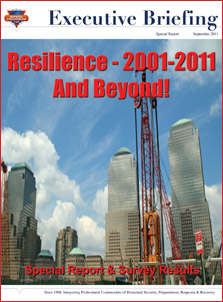Following the terrorist attacks of 11 September 2001, the idea that the nation’s “critical infrastructure” should be protected became a high priority within the new emphasis on improving all aspects of U.S. homeland security. Because of the potentially very high costs involved in providing full protection, the term “resilience” was pushed to the forefront of discussions on recovery efforts within the United States. Government agencies as well as private-sector businesses and numerous agencies and organizations, both public and private, began to inject “resiliency” thinking and actions into their planning processes. However, defining and describing “resilience” across multiple sectors has been a continuing challenge for many years and, in and of itself, does not adequately describe what the nation as a whole must do to  achieve greater resiliency.
achieve greater resiliency.
The White House’s Office of Science and Technology Policy created a descriptive definition, as follows, to clearly outline specific plans and actions that should be taken into account in order to achieve resilience: “A community’s or region’s ability to effectively prepare for, respond to, and successfully recover from a manmade or natural disaster, by having the ability to quickly: return citizens to work, minimize disruption to life and economies, reopen schools and businesses, and prevent and mitigate cascading failures, often characteristic of critical infrastructure impacts.”
Since September 2001, significant resources have been allocated to building a more resilient nation. Today, ten years after the 9/11 attacks, emergency planners, responders, receivers, and other stakeholders – across the public and private sectors, in academia, and in non-profit organizations – are evaluating the progress and advances made to better protect communities, and the critical infrastructure at all levels of government, needed to create and preserve a more resilient nation.
Key Findings: Many Agreements, Some Differences
Over the past decade, considerable effort and significant resources have been devoted to creating and improving the nation’s resilience. However, in terms of what has been accomplished, what is currently implemented, and what still needs to be done, some interesting gaps as well as synergies have become apparent in the respective responses received from DomPrep40 Advisors (DP40) and DomPrep readers (readers):
(a) While the majority of both groups have an understanding of resilience, many of the readers have not yet incorporated resilience into their own organizational plans. (b) A large number of readers have considered training citizen volunteer groups or forming their own groups of volunteers to assist during a large-scale event, whereas the largest response from the DP40 indicates the opposite because of risk concerns. (c) Respondents are in general agreement that not all individuals, families, and communities are as well prepared for future threats as they should be. (d) Even some professionals who are responsible for making their organizations more resilient have still not started to take the steps needed to be more resilient in their personal lives.
Click to download Full Report
